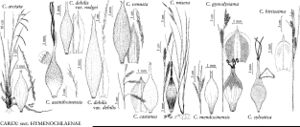Carex assiniboinensis
Bot. Gaz. 9: 91. 1884.
Plants densely cespitose, also producing long-arching stolons that root at the tip and form new plants. Culms dark maroon at base; flowering-stems 35–75 cm, longer than leaves at maturity, 0.5–0.8 mm thick, glabrous or minutely scabrous on angles, especially within inflorescence. Leaves: basal sheaths maroon, bladeless, glabrousl; others grading from maroon to green on back, pale hyaline on front; blades flat, 1–3 mm wide, glabrous on adaxial surface, often strigose on abaxial surface, margins and midribs of abaxial surface scabrous at distal end. Inflorescences: peduncles of lateral spikess 20–60 mm, glabrous; peduncle of ternimal spike 40–60 mm, glabrous or minutely scabrous on angles; proximal bracts much shorter than inflorescence; sheaths 15–25 mm; blades 1.5–2.2 mm wide. Lateral spikes 2–5, pistillate with fewer than 10 perigynia attached 3–15 mm apart, 1 spike per node, well separated, erect or drooping, linear, 5–30 × 3–5 mm; distal spikes sometimes staminate and shorter than terminal spike. Terminal spike staminate, 11–30 × 1.5–3 mm. Pistillate scales pale hyaline, often partially suffused with chestnut-brown, with narrow green midrib, lanceolate to oblong, shorter than mature pergiynia, apex cuspidate or acuminate with serrulate green awn 1–3 mm, glabrous. Perigynia green, at least body maturing to yellow, 2-ribbed but not obviously otherwise veined, except sometimes near base, tightly enveloping achene, lanceellipsoid, 5–6.5 × 0.8–1.8 mm, cartilaginous, base with stipe 0.5 mm, apex tapering gradually to beak, short-pubescent; beak oblique to minutely toothed, 2.5 mm. Achenes stipitate, 1.8–2.5 × 0.7–1 mm, stipe adnate to thickened perigynium base, breaking from achene at maturity. 2n = 32.
Phenology: Fruiting summer.
Habitat: Floodplain forests, old river channels and riverbanks, mesic deciduous and mixed conifer-hardwood forests, thickets
Distribution

Man., Ont., Sask., Iowa, Mich., Minn., N.Dak., S.Dak., Wis.
Discussion
Carex assiniboinensis is easy to recognize in mid to late summer because it forms long-arching stolons that root at the tip to form new plantlets. The stoloniferous habit, which was given taxonomic status as C. assiniboinensis forma ambulans by J.-P. Bernard (1959), is typical for the species. Although some herbarium specimens lack the stolons because they were collected early in the season, most if not all populations appear to form the stolons by late summer.
Selected References
None.
Lower Taxa
"shortened" is not a number."thick" is not a number.
